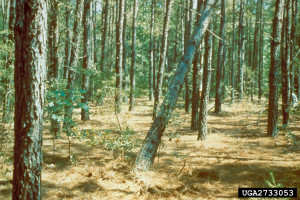
Many Georgia landowners with property along, or south of, the fall line (running from Augusta to Columbus) are noticing dead and dying trees in their pine stand. These stands were thinned one to five years ago and are located mainly on sandy to sandy loam soils. First impressions are that these stands are infested with pine bark beetles and this is a bark beetle problem.
Further inspection of these stands reveals they have a more serious problem called Heterobasidion Root Disease (HRD). The fungus that causes HRD enters pine stands when its airborne spores land on the freshly cut stump or root surfaces. The spores progress downward through the root system and then spread to adjacent healthy trees through root contacts in the soil.

Infected trees begin to show symptoms 3-5 years following thinning. Crowns thin, turn light green to yellow and have shortened needles that may be tufted at the branch ends. These symptoms are very noticeable when sick trees are compared to healthy trees. The fungus can rot the roots so badly that some trees may fall over on their own or do so during moderate to heavy winds. Wind-thrown trees in a pine plantation may indicate root rot.
Pine bark beetles are often associated with Heterobasidion Root Disease since the trees are weakened from the disease, making the trees more susceptible to pine beetle attacks. Many landowners think they have a pine beetle problem when they actually have a root disease problem.
We are happy to assist with any questions or concerns you may have. If you can’t find something you are looking for, please let us know, and we will be glad to help.
